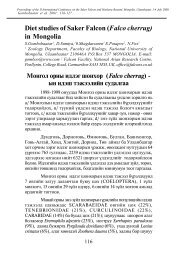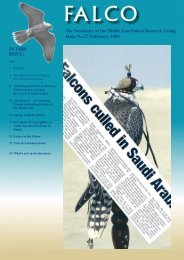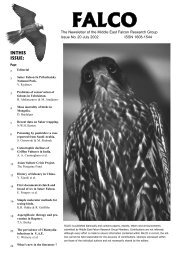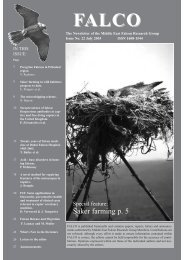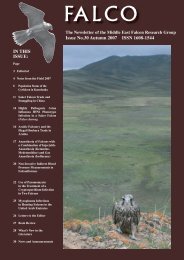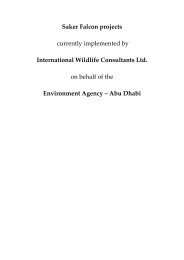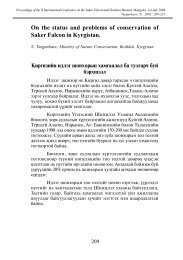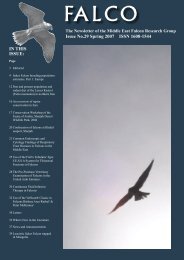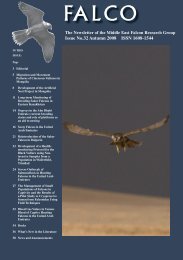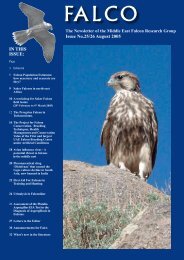aglobalstrategy for the conservation of falcons and houbara
aglobalstrategy for the conservation of falcons and houbara
aglobalstrategy for the conservation of falcons and houbara
Create successful ePaper yourself
Turn your PDF publications into a flip-book with our unique Google optimized e-Paper software.
A GLOBAL STRATEGY<br />
FOR THE CONSERVATION<br />
OF FALCONS AND HOUBARA
PUBLISHER:<br />
National Avian Research Center<br />
Environmental Research <strong>and</strong> Wildlife Development Agency<br />
PO Box 45553, Abu Dhabi, United Arab Emirates<br />
Telephone: (9712) 319317<br />
Fax: (9712) 349154<br />
E-mail: ERWDA@emirates.net.ae<br />
Internet: http://www.erwda.gov.ae<br />
Written by Dr Nick Fox, Mohamed Al Bowardi,<br />
Helen Macdonald <strong>and</strong> Frederic Launay<br />
Designed by Helen Macdonald,<br />
Dr Nick Fox <strong>and</strong> Sean Tapp<br />
ACKNOWLEDGEMENTS<br />
Pictures by Wilfred Thesiger, Dr Nick Fox, Mr Mohamed Al Bowardi, Brigadier Mukhtar<br />
Ahmed, Tom Bailey, Theresa Bailey, Erin Gott, Jaime Samour, Mark Watson, Chris<br />
Eastham, Helen Macdonald, Martyn Paterson, Peter Hellyer
CONTENTS<br />
Foreword by HH Sheikh Zayed bin Sultan Al Nayhan x<br />
Arabian Falconers Association x<br />
National Falconers Associations x<br />
Abu Dhabi Falcon Hospital x<br />
The UAE National Falconers Club<br />
x<br />
Conservation <strong>and</strong> Research x<br />
Houbara Field Research in <strong>the</strong> UAE x<br />
Houbara Research in <strong>the</strong> Range Countries x<br />
Houbara Captive Breeding Program x<br />
The Houbara Year x<br />
International Laws <strong>and</strong> Agreements on <strong>the</strong> Houbara x<br />
The Hare <strong>and</strong> Kurrowan x<br />
The Saker Falcon x<br />
The Peregrine x<br />
The Lugger Falcon x<br />
Captive Bred Falcons x<br />
The Falcon Year x<br />
The Middle East Falcon Research Group x<br />
The Hunting Grounds x
A Global Strategy<br />
<strong>for</strong> <strong>the</strong> Conservation <strong>of</strong> Falcon <strong>and</strong> Houbara Resources
Twenty-one years ago we hosted our first international ga<strong>the</strong>ring <strong>of</strong><br />
bro<strong>the</strong>r falconers from all over <strong>the</strong> world. Now, as this millenium<br />
draws to a close <strong>and</strong> we prepare ourselves <strong>for</strong> a new one, it is even<br />
more important that we come toge<strong>the</strong>r to secure <strong>the</strong> future <strong>for</strong> our<br />
children <strong>and</strong> <strong>the</strong> world that <strong>the</strong>y will inherit from us. It is truly said<br />
that we borrow <strong>the</strong> world from our children <strong>and</strong> hold it in trust <strong>for</strong><br />
<strong>the</strong>m.<br />
The traditional sport <strong>of</strong> falconry was passed down to us from our<br />
fa<strong>the</strong>rs, from a time when we were closer to nature <strong>and</strong> life was<br />
more simple. It is a constant reminder to us <strong>of</strong> <strong>the</strong> <strong>for</strong>ces <strong>of</strong> nature,<br />
<strong>of</strong> <strong>the</strong> inter-relationships between living things <strong>and</strong> <strong>the</strong> l<strong>and</strong> <strong>the</strong>y<br />
share, <strong>and</strong> <strong>of</strong> our own dependence on nature. Falconry depends on<br />
healthy populations <strong>of</strong> <strong>the</strong> quarry, such as <strong>the</strong> Houbara, <strong>and</strong> <strong>the</strong>y in<br />
turn depend on <strong>the</strong> continuing health <strong>of</strong> <strong>the</strong>ir breeding <strong>and</strong> wintering<br />
grounds. Falconers thus have a concern <strong>for</strong> natural habitats <strong>and</strong> <strong>for</strong><br />
<strong>the</strong> sustainable use <strong>of</strong> resources.<br />
During my own lifetime I have seen many remarkable changes <strong>and</strong><br />
achievements occur in <strong>the</strong> Middle East. Oil has brought immense<br />
benefits <strong>for</strong> <strong>the</strong> welfare <strong>of</strong> our people. But progress can also pose<br />
problems <strong>for</strong> nature - pollution <strong>of</strong> l<strong>and</strong> <strong>and</strong> sea, unwanted<br />
development <strong>and</strong> spoiling <strong>of</strong> natural areas, <strong>and</strong> disturbance <strong>of</strong> quiet<br />
places which once gave refuge to wildlife. Some <strong>of</strong> <strong>the</strong> prey species<br />
have suffered from loss <strong>of</strong> habitat, <strong>and</strong> from persecution or overhunting.<br />
It is important <strong>for</strong> us to take steps to turn <strong>the</strong> tide be<strong>for</strong>e it<br />
is too late, in order to safeguard <strong>the</strong> future.<br />
This plan is essential in helping us to recognise how <strong>the</strong>se complex<br />
systems interrelate <strong>and</strong> depend on each o<strong>the</strong>r. It helps us to see<br />
clearly our way <strong>for</strong>ward <strong>and</strong> our priorities <strong>for</strong> action. So much is<br />
already being achieved by many organisations in many countries.<br />
We will reach our goals by working toge<strong>the</strong>r, h<strong>and</strong>-in-h<strong>and</strong>, in cooperation,<br />
not by confrontation.<br />
Foreword by<br />
His Highness<br />
Sheikh Zayed bin Sultan Al Nahyan,<br />
Ruler <strong>of</strong> <strong>the</strong> United Arab Emirates<br />
All <strong>of</strong> us share a common goal: <strong>the</strong> sustainable, balanced use <strong>of</strong><br />
resources. We wish to leave <strong>the</strong> Earth as good, or better, than we<br />
found it.
THE ARABIAN FALCONERS ASSOCIATION<br />
AIMS<br />
To cater <strong>for</strong> all Arab falconers’ needs<br />
To provide international representation <strong>for</strong> Arab falconry<br />
To work <strong>for</strong> improvements in <strong>the</strong> health <strong>and</strong><br />
welfare <strong>of</strong> captive <strong>falcons</strong><br />
To monitor wild falcon <strong>and</strong> quarry populations <strong>and</strong> work<br />
<strong>for</strong> <strong>the</strong>ir continued health through programmes <strong>of</strong><br />
research <strong>and</strong> <strong>conservation</strong> funded by falconers<br />
To monitor national <strong>and</strong> international laws <strong>and</strong><br />
Agreements relating to falconry<br />
To represent Arab falconry on <strong>the</strong><br />
international falconry scene<br />
To support falconry all over <strong>the</strong> world<br />
To hold international falconry meetings<br />
A LANDMARK IN THE HISTORY OF FALCONRY<br />
A centuries-old tradition - a matchless rapport with <strong>the</strong>ir birds -<br />
Falconers throughout <strong>the</strong> Middle East have a unique heritage. There are<br />
more falconers in <strong>the</strong> Middle East than anywhere else in <strong>the</strong> world.<br />
In an Arabian Falconers Union, <strong>the</strong>se falconers would possess great strength<br />
- strength to conserve <strong>and</strong> protect <strong>for</strong> <strong>the</strong> future those very things upon<br />
which falconry depends - wild <strong>falcons</strong>, <strong>the</strong> <strong>houbara</strong>, kurrowan <strong>and</strong> hare, <strong>and</strong><br />
<strong>the</strong> fragile hunting grounds.<br />
STRUCTURE<br />
Board <strong>of</strong> National Representatives<br />
From each National Falconers Association<br />
Co-opted Specialists<br />
Offering a scientific advisory service<br />
Spokesman<br />
Secretary<br />
Treasurer<br />
Media <strong>and</strong> Public relations
THE NATIONAL FALCONERS’<br />
ASSOCIATIONS<br />
OF EACH MEMBER STATE<br />
OF THE ARABIAN FALCONERS ASSOCIATION<br />
AIMS<br />
To bring toge<strong>the</strong>r falconers <strong>and</strong> in<strong>for</strong>mation<br />
To produce magazine or newsletter<br />
To hold local meetings <strong>and</strong> talks<br />
To open a National Falconry Center <strong>and</strong> Falcon Hospital<br />
To ensure that enough quarry is available <strong>for</strong> falconers<br />
To administer local hunting<br />
To maintain national falconry archives<br />
To maintain a PIT microchip database<br />
To help administer CITES<br />
To hold international conferences<br />
To teach <strong>and</strong> help young falconers
NATIONAL FALCONERS ASSOCIATION<br />
ABU DHABI FALCON<br />
HOSPITAL<br />
Specialising in <strong>the</strong> care <strong>and</strong> treatment <strong>of</strong> <strong>falcons</strong>, <strong>the</strong><br />
wildlife veterinary research institute <strong>of</strong> <strong>the</strong> UAE<br />
National Falconers Association will also research <strong>the</strong><br />
health <strong>and</strong> disease <strong>of</strong> wildlife in <strong>the</strong> UAE. The<br />
Headquarters at Mafraq, Abu Dhabi, are open to <strong>the</strong><br />
General Public <strong>and</strong> provide a veterinary service to<br />
<strong>falcons</strong> <strong>and</strong> o<strong>the</strong>r animals.<br />
It is staffed by specialist falcon veterinarians <strong>for</strong> <strong>the</strong><br />
highest st<strong>and</strong>ard <strong>of</strong> health care.<br />
Bumblefoot<br />
Serratospiculum worm inside a falcon<br />
RESEARCH PROJECTS<br />
On falcon health problems aiming to<br />
improve <strong>the</strong> medical <strong>and</strong> surgical care <strong>of</strong><br />
<strong>falcons</strong><br />
QUARANTINE UNIT<br />
ISOLATION WARDS<br />
For isolation <strong>of</strong> recently imported <strong>falcons</strong> to<br />
ensure <strong>the</strong>y are healthy be<strong>for</strong>e being trained<br />
HOSPITAL WARDS<br />
For <strong>falcons</strong> undergoing veterinary treatment<br />
Staffed by specialist falcon veterinarians <strong>for</strong> <strong>the</strong> highest st<strong>and</strong>ard <strong>of</strong><br />
healthcare<br />
Using an endoscope to<br />
examine a live falcon
MOULTING<br />
WARDS<br />
Modern quarters <strong>for</strong> moulting<br />
<strong>falcons</strong> under contract.<br />
Falcons maintained on a top<br />
quality diet with vitamin<br />
supplements to ensure strong new<br />
fea<strong>the</strong>rs <strong>and</strong> good overall health.<br />
PUBLIC<br />
AWARENESS UNIT<br />
To promote public awareness <strong>of</strong><br />
health <strong>and</strong> disease issues in<br />
captive <strong>falcons</strong><br />
To encourage good husb<strong>and</strong>ry <strong>of</strong><br />
captive <strong>falcons</strong><br />
To promote <strong>the</strong> sustainable use<br />
<strong>of</strong> <strong>the</strong> <strong>houbara</strong> as a quarry<br />
species<br />
Anaes<strong>the</strong>tising a falcon be<strong>for</strong>e<br />
examination<br />
To show <strong>the</strong> importance <strong>of</strong><br />
falconry to Arab cultural<br />
heritage<br />
FALCON HEALTH<br />
INSURANCE<br />
May be purchased <strong>for</strong> <strong>falcons</strong><br />
MOBILE CLINIC<br />
First aid <strong>and</strong> health care <strong>for</strong> <strong>falcons</strong> on<br />
hunting expeditions
NATIONAL FALCONERS ASSOCIATION<br />
THE EMIRATES FALCONERS' CLUB<br />
ESSENTIAL MODERN FACILITIES FOR THE FALCONER<br />
This center, currently still in <strong>the</strong> planning stage, will have<br />
immense benefit <strong>for</strong> Falconers in <strong>the</strong> UAE. A central base <strong>for</strong><br />
<strong>the</strong> National Falconers Association, it will fulfill many roles.<br />
SALES ROOMS<br />
Modern sales rooms <strong>for</strong><br />
<strong>falcons</strong><br />
The education <strong>of</strong> young people will be a priority, not only<br />
young falconers - but to teach everyone <strong>the</strong> true tenets <strong>of</strong><br />
falconry - a love <strong>and</strong> respect <strong>for</strong> both <strong>the</strong> falcon <strong>and</strong> quarry,<br />
a deep <strong>and</strong> abiding concern <strong>for</strong> <strong>the</strong> health <strong>of</strong> <strong>the</strong> hunting<br />
grounds, <strong>and</strong> an awareness <strong>of</strong> <strong>the</strong> unbroken line <strong>of</strong> tradition<br />
which follows falconry back to <strong>the</strong> very earliest days <strong>of</strong> <strong>the</strong><br />
Arab people.<br />
Falcon sales rooms<br />
SPORTING AGENCY<br />
OFFICE<br />
Co-ordinating hunting<br />
trips <strong>for</strong> Arab falconers<br />
<strong>and</strong> sportsmen abroad<br />
COLD STORES<br />
FOR FALCON<br />
FOOD<br />
Top quality food to keep<br />
<strong>falcons</strong> in <strong>the</strong> best <strong>of</strong><br />
health
NATIONAL FALCONERS ASSOCIATION<br />
OFFICE<br />
CITES OFFICE<br />
Authority dealing with <strong>the</strong> import <strong>of</strong> <strong>falcons</strong> into<br />
<strong>the</strong> UAE<br />
MEFRG OFFICE<br />
National Headquarters <strong>of</strong> <strong>the</strong> Middle East Falcon<br />
Research Group<br />
EXHIBITION HALL<br />
For falconry <strong>and</strong> falcon related<br />
exhibitions<br />
hunting equipment<br />
fine art <strong>of</strong> <strong>falcons</strong> <strong>and</strong> wildlife<br />
<strong>conservation</strong><br />
Arabian Sporting Heritage<br />
SHOP<br />
Allowing easy access to <strong>the</strong><br />
world’s best books, health care<br />
<strong>and</strong> falconry equipment<br />
CONFERENCE FACILITIES<br />
For conferences on:<br />
Falconry<br />
Wildlife legislation<br />
Conservation
Photographing a wild<br />
saker falcon as part <strong>of</strong><br />
a scientific study into<br />
<strong>the</strong> relationship between<br />
different types <strong>of</strong> saker<br />
falcon<br />
CONSERVATION AND<br />
RESEARCH<br />
A priority <strong>for</strong> <strong>the</strong> future <strong>of</strong> Arab falconry.<br />
The commitment <strong>of</strong> <strong>the</strong> Arab Falconers’ Association<br />
to wise <strong>conservation</strong> will be absolute. What would<br />
falconry be with no <strong>falcons</strong>? What would falconry be<br />
if <strong>the</strong> hunting grounds are bare <strong>of</strong> quarry? Research<br />
projects are <strong>the</strong> first stage in creating practical<br />
<strong>conservation</strong> programmes. Their contribution to <strong>the</strong><br />
continuation <strong>of</strong> species - <strong>and</strong> <strong>the</strong> future <strong>of</strong> falconry -<br />
cannot be overestimated.<br />
<br />
<br />
<br />
<br />
<br />
<br />
<br />
STAGE II<br />
PREPARATION<br />
Develop <strong>the</strong> project structure<br />
Estimate costs<br />
Prepare budgets<br />
Obtain funds<br />
Obtain relevant permits (fieldwork<br />
permits, CITES)<br />
Hire staff<br />
Sign Research Agreement between<br />
government <strong>and</strong>/or non-governmental<br />
organisations<br />
<br />
<br />
<br />
STAGE I<br />
PRELIMINARY<br />
DISCUSSIONS<br />
Identify <strong>the</strong> aims <strong>of</strong> <strong>the</strong> project<br />
Identify suitable biologists <strong>and</strong> institutions<br />
Sign a Memor<strong>and</strong>um <strong>of</strong> Underst<strong>and</strong>ing<br />
between government <strong>and</strong>/or nongovernmental<br />
organisations<br />
Representatives from <strong>the</strong> National<br />
Academy <strong>of</strong> Sciences, Kazakhstan,<br />
signing a collaborative <strong>houbara</strong><br />
Research Agreement with NARC
STAGE V<br />
RESULTS<br />
Secure a sustainable, long-term future <strong>for</strong> <strong>the</strong><br />
target species, <strong>the</strong> habitat in which it lives,<br />
<strong>and</strong><br />
o<strong>the</strong>r species dependent upon those<br />
habitats<br />
Closer ties <strong>and</strong> underst<strong>and</strong>ing at all levels between<br />
participating countries<br />
Funds, resources <strong>and</strong> training <strong>for</strong> range countries’<br />
biologists <strong>and</strong> scientific institutions<br />
<br />
<br />
<br />
<br />
<br />
<br />
STAGE IV<br />
PROGRESS<br />
Progress reports<br />
Visiting field teams<br />
Receiving data<br />
Processing data<br />
Re-evaluating project (meetings, workshops,<br />
conferences, feedback, external advice)<br />
Publishing results (scientific journals, popular media,<br />
articles etc.)<br />
Radiotagged young saker <strong>falcons</strong><br />
Measuring a wild saker falcon<br />
Teaching climbing<br />
skills at a NARC<br />
fieldworker training seminar<br />
Studying saker falcon diet in Kazakhstan: a NARC fieldworker weighs a suslik<br />
STAGE III<br />
SETTING UP<br />
Direct <strong>the</strong> project internationally<br />
Manage <strong>the</strong> project nationally<br />
Link with sister projects (e.g. through <strong>the</strong><br />
MEFRG PIT scheme, migration studies)<br />
Communicate in different languages<br />
St<strong>and</strong>ardise methods <strong>and</strong> data (e.g. a manual <strong>of</strong><br />
scientific protocols <strong>and</strong> datasheets)<br />
Obtain equipment <strong>and</strong> transport<br />
Get funds <strong>and</strong> supplies to fieldwork countries <strong>and</strong> teams<br />
Maintain resource <strong>and</strong> cash flow schedules<br />
Optimise use <strong>of</strong> resources<br />
Transport scientific specimens/material to<br />
o<strong>the</strong>r institutions <strong>for</strong> analysis<br />
Manual <strong>of</strong> scientific protocols
HOUBARA FIELD RESEARCH IN THE UAE<br />
The arrival <strong>of</strong> <strong>the</strong> Houbara in <strong>the</strong> United Arab Emirates has been a much-awaited event <strong>for</strong><br />
hundreds <strong>of</strong> years. Falconers <strong>and</strong> <strong>the</strong>ir <strong>falcons</strong> must use all <strong>the</strong>ir traditional skills to track <strong>the</strong> shy<br />
<strong>houbara</strong> during <strong>the</strong> winter months. Nowadays, fewer <strong>and</strong> fewer <strong>houbara</strong> visit <strong>the</strong> UAE. We need to<br />
discover <strong>the</strong> reasons behind <strong>the</strong>ir declining numbers, <strong>and</strong> we need to know how to halt this decline<br />
be<strong>for</strong>e <strong>the</strong> <strong>houbara</strong> becomes extinct in <strong>the</strong> UAE.<br />
To catch live <strong>houbara</strong> <strong>for</strong> research<br />
purposes, this Saker wears a special hood<br />
<strong>and</strong> has beads glued to its talons. It can<br />
catch <strong>houbara</strong>, but <strong>the</strong> <strong>houbara</strong> remain<br />
unharmed.<br />
ASSESS AND CHECK THE<br />
DISTRIBUTION AND OCCURRENCE OF<br />
HOUBARA THROUGHOUT THE<br />
COUNTRY<br />
Fresh <strong>houbara</strong> tracks<br />
Houbara trapped in Baynunah, UAE, <strong>for</strong> research purposes<br />
MONITOR THE WINTERING POPULATION OF<br />
HOUBARA IN THE UAE IN ORDER TO<br />
EVALUATE POPULATION TRENDS<br />
Surveying Houbara<br />
habitat in <strong>the</strong> UAE<br />
CREATE NETWORKS OF WILDLIFE RANGERS TO<br />
MONITOR THE UAE HOUBARA POPULATION<br />
COUNTRYWIDE
ASSESS AND MONITOR<br />
THE IMPACT<br />
OF HUNTING AND<br />
DISTURBANCE<br />
ON THE UAE HOUBARA<br />
POPULATION<br />
MONITOR HOUBARA NUMBERS IN<br />
THE UAE<br />
IMPLEMENT RESEARCH ACTIVITIES<br />
TO INVESTIGATE:<br />
Houbara habitat choice<br />
Houbara diet<br />
Genetic studies on <strong>the</strong> origin <strong>of</strong> wintering<br />
populations<br />
Time <strong>of</strong> <strong>houbara</strong> arrival <strong>and</strong> departure<br />
The numbers <strong>and</strong> distribution <strong>of</strong> <strong>the</strong><br />
<strong>houbara</strong> in <strong>the</strong> UAE<br />
IDENTIFY TRENDS IN<br />
THE HOUBARA<br />
POPULATION AND<br />
HABITAT<br />
AVAILABILITY<br />
IN THE UAE<br />
ESTABLISH<br />
PROTECTED<br />
MANAGED AREAS<br />
(HOME HUNTING<br />
GROUNDS) FOR<br />
HOUBARA<br />
Fitting a satellite transmitter to a<br />
<strong>houbara</strong> trapped in Baynunah: by<br />
satellite tracking UAE <strong>houbara</strong> we<br />
can discover where <strong>the</strong>y breed
CHINA<br />
Collaborative research on:<br />
Breeding biology<br />
(Productivity)<br />
Migration<br />
Distribution<br />
Population Dynamics<br />
Population Monitoring<br />
NARC Houbara fieldworkers with colleagues in Pakistan<br />
HOUBARA RESEARCH IN<br />
THE RANGE COUNTRIES<br />
The Asian Houbara Bustard is a widely distributed bird found<br />
in twenty-three countries. Some populations are migratory<br />
<strong>and</strong> travel thous<strong>and</strong>s <strong>of</strong> kilometers to reach <strong>the</strong>ir wintering<br />
grounds in <strong>the</strong> Arabian Peninsula. The responsibility <strong>of</strong><br />
ensuring a secure future <strong>for</strong> <strong>the</strong>se birds rests with all <strong>the</strong><br />
countries crossed by <strong>the</strong> <strong>houbara</strong>. A concerted, integrated<br />
ef<strong>for</strong>t to conserve <strong>the</strong> <strong>houbara</strong> is <strong>the</strong>re<strong>for</strong>e essential.<br />
PAKISTAN<br />
Rehabilitation Center<br />
(Houbara Foundation<br />
International) <strong>for</strong> confiscated<br />
Houbara<br />
Assessment <strong>and</strong> control <strong>of</strong><br />
Houbara trade<br />
Assessment <strong>of</strong> <strong>the</strong> impact <strong>of</strong><br />
hunting <strong>and</strong> trapping<br />
Breeding biology (productivity)<br />
Migration<br />
This satellite-tagged Houbara, trapped in <strong>the</strong> UAE, was tracked<br />
all <strong>the</strong> way back to its breeding grounds in China, giving<br />
essential data on <strong>houbara</strong> migration routes
KAZAKHSTAN<br />
Collaborative research on:<br />
Assessment <strong>of</strong> <strong>the</strong><br />
impact <strong>of</strong> hunting <strong>and</strong><br />
trapping<br />
Breeding Biology<br />
(Productivity)<br />
Migration<br />
Distribution<br />
Population Dynamics<br />
Population Monitoring<br />
GLOBAL MANAGEMENT OF THE WILD POPULATION<br />
OF THE ASIAN HOUBARA BUSTARD<br />
THROUGHOUT ITS RANGE<br />
ARABIAN<br />
PENINSULA<br />
(Oman, Saudi Arabia,<br />
Yemen, UAE)<br />
Distribution<br />
Breeding population<br />
Protected Areas<br />
Trends in <strong>the</strong> population<br />
Migration<br />
Breeding range<br />
Wintering range<br />
Illegally-trapped <strong>houbara</strong> awaiting release back into <strong>the</strong> wild at a rehabilitation center in Pakistan
Captive-bred Houbara<br />
HOUBARA CAPTIVE<br />
BREEDING PROGRAM<br />
The overall aim <strong>of</strong> breeding <strong>houbara</strong> in captivity is to provide a sustainable quarry<br />
resource by increasing <strong>the</strong> number <strong>of</strong> <strong>houbara</strong> wintering in Abu Dhabi. It is hoped<br />
this can be achieved through an appropriate combination <strong>of</strong> captive breeding <strong>and</strong><br />
release, improving habitat, <strong>and</strong> by establishing <strong>and</strong> conserving breeding populations<br />
centered on intensively managed protected areas.<br />
AIMS OF THE HOUBARA BREEDING PROGRAM<br />
To breed <strong>houbara</strong> cost-effectively in captivity <strong>for</strong> release to supplement<br />
<strong>the</strong> UAE’s wintering population<br />
To release <strong>houbara</strong> <strong>for</strong> hunting<br />
To re-stock wild populations on <strong>the</strong>ir wintering <strong>and</strong> breeding grounds<br />
To provide <strong>houbara</strong> <strong>for</strong> training <strong>falcons</strong><br />
Collecting semen from a h<strong>and</strong>-reared male <strong>houbara</strong><br />
by persuading it to mate with a model female<br />
Workers from<br />
<strong>the</strong> National<br />
Avian<br />
Research<br />
Center
RESEARCH INTO<br />
NARC’s desert research station at Sweihan, Abu Dhabi, where research into captive breeding is carried out<br />
Artificial insemination<br />
Nutrition <strong>and</strong> diet<br />
Physiology <strong>of</strong> Reproduction<br />
Release techniques<br />
Rearing <strong>and</strong> h<strong>and</strong>ling<br />
techniques<br />
Genetic management <strong>of</strong> <strong>the</strong><br />
captive population<br />
Behaviour in Captivity<br />
Health<br />
INTERNATIONAL COLLABORATION<br />
Increase <strong>the</strong> exchange <strong>of</strong> birds between captive breeding centers to maximise <strong>the</strong>ir genetic<br />
variation <strong>and</strong> reduce <strong>the</strong> need to collect birds from <strong>the</strong> wild<br />
Establish a database <strong>of</strong> <strong>the</strong> origins <strong>of</strong> each captive <strong>houbara</strong><br />
Share expertise <strong>and</strong> in<strong>for</strong>mation between captive breeding centers<br />
Shaded breeding pens at NARC’s<br />
Sweihan research station<br />
H<strong>and</strong>-feeding captive<br />
bred Houbara to keep <strong>the</strong>m<br />
tame <strong>and</strong> used to human contact<br />
Feeding a captive-bred <strong>houbara</strong> chick
THE HOUBARA YEAR<br />
The life story <strong>of</strong> <strong>the</strong> Houbara takes place over thous<strong>and</strong>s <strong>of</strong> miles <strong>and</strong> many countries. Some <strong>houbara</strong> stay year-round in <strong>the</strong> same region.<br />
Most <strong>houbara</strong> spend <strong>the</strong> winter thous<strong>and</strong>s <strong>of</strong> miles from <strong>the</strong>ir breeding grounds. We must ensure that <strong>the</strong> <strong>houbara</strong> is protected from hunting<br />
during <strong>the</strong> vulnerable times <strong>of</strong> <strong>the</strong> year - during courtship, egg-laying <strong>and</strong> chick rearing. This diagram shows <strong>the</strong> movements <strong>and</strong> life-cycle <strong>of</strong><br />
<strong>the</strong> <strong>houbara</strong>, <strong>and</strong> shows those seasons when responsible falconers should hunt <strong>houbara</strong>, <strong>and</strong> those seasons when <strong>the</strong> <strong>houbara</strong> should be left<br />
unhunted, to breed in peace, producing many young <strong>houbara</strong> <strong>for</strong> <strong>the</strong> next season’s hunting.<br />
AUTUMN<br />
MIGRATION<br />
PRE-MIGRATION<br />
POPULATION<br />
AUGUST<br />
No Hunting<br />
CHICKS<br />
EGGS<br />
BREEDING<br />
GROUNDS<br />
JULY<br />
No Hunting<br />
JUNE<br />
No Hunting<br />
SPRING<br />
MIGRATION<br />
APRIL<br />
Egg-laying<br />
MAY<br />
No Hunting<br />
HOUBARA<br />
BREEDING<br />
ADULTS
HOUBARA WIN-<br />
TERING IN<br />
ARABIA<br />
NOVEMBER<br />
Managed Hunting<br />
OCTOBER<br />
Managed<br />
Hunting<br />
SEPTEMBER<br />
No hunting<br />
DECEMBER<br />
Managed<br />
Hunting<br />
PRE-MIGRATION<br />
POPULATION<br />
JANUARY<br />
Managed<br />
Hunting<br />
FEBRUARY<br />
Managed Hunting<br />
(special cases)<br />
MARCH<br />
Egg-laying
INTERNATIONAL AGREEMENTS<br />
ON THE HOUBARA BUSTARD<br />
The Houbara Bustard is a bird <strong>of</strong> great international importance<br />
due to its wide distribution across much <strong>of</strong> Asia <strong>and</strong> north Africa.<br />
The migratory existence <strong>of</strong> <strong>the</strong> <strong>houbara</strong> means that over-hunting<br />
or habitat loss in one country may affect Houbara populations in<br />
ano<strong>the</strong>r. International ef<strong>for</strong>ts are <strong>the</strong>re<strong>for</strong>e essential to ensure <strong>the</strong><br />
long-term survival <strong>of</strong> this beautiful bird.<br />
CMS<br />
CONVENTION ON THE CONSERVATION OF<br />
MIGRATORY SPECIES OF WILD ANIMALS, BONN,<br />
1979<br />
CMS CONFERENCE OF THE PARTIES<br />
THIRD MEETING, NAIROBI 1994<br />
Appendix I:<br />
Northwest African Houbara (endangered)<br />
Appendix II:<br />
Asian Houbara (Unfavourable Conservation Status)<br />
CMS CONFERENCE OF THE PARTIES<br />
SECOND MEETING, GENEVA 1991<br />
Recommend <strong>the</strong> transfer <strong>of</strong> Houbara<br />
from CITES Annex I to Annex II be<strong>for</strong>e <strong>the</strong> next CITES<br />
Conference <strong>of</strong> <strong>the</strong> Parties<br />
CITES<br />
CONVENTION ON INTERNATIONAL TRADE IN<br />
ENDANGERED FLORA AND FAUNA,<br />
WASHINGTON 1973<br />
Appendix I: Houbara (threatened with extinction)
HOUBARA<br />
MANAGEMENT PLAN<br />
DRAFT AGREEMENT ON THE<br />
CONSERVATION AND MANAGEMENT<br />
OF THE ASIAN HOUBARA<br />
November 1995<br />
Parties to <strong>the</strong> Bonn Convention on Houbara<br />
PROPOSED HOUBARA MANAGEMENT COMMITTEE<br />
5 Experts representing different range counties<br />
1 Representative from Western Conservation Organisations<br />
1 Representative from Arab Falconers<br />
1 Expert on Houbara Bustard Management<br />
1 Expert on Rural Development<br />
1 Expert on Environmental Law<br />
Up to 3 Observers from International Organisations<br />
DRAFT AGREEMENT AREA<br />
Afghanistan, Bahrein, China, India, Iran, Iraq, Kazakhstan, Kuwait, Mongolia,<br />
Oman, Pakistan, Qatar, Russia, Saudi Arabia, Turkmenistan, United Arab<br />
Emirates, Uzbekhistan, Yemen<br />
CONSERVATION FUND<br />
Identify sources <strong>of</strong> funding <strong>and</strong> where funds will be spent<br />
CMS CONFERENCE OF THE PARTIES,<br />
FOURTH MEETING, GENEVA 1997<br />
CONVENTION ON BIOLOGICAL<br />
DIVERSITY 1992<br />
THE AFRICAN CONVENTION ON THE<br />
CONSERVATION OF NATURE AND<br />
NATURAL RESOURCES 1968
RESEARCH<br />
CAPTIVE<br />
QUARRY SPECIES<br />
Captive breeding<br />
Incubation studies<br />
Health studies<br />
Diet studies<br />
Behavioural studies<br />
Genetic studies<br />
Growth studies<br />
Release techniques<br />
THE KURROWAN AND HARE<br />
The ageless flight <strong>of</strong> <strong>the</strong> saker at <strong>houbara</strong> - <strong>the</strong> peregrine at kurrowan.<br />
The falconer, kneeling by his falcon after it has caught a desert hare.<br />
These precious moments rest upon <strong>the</strong> delicate balance between<br />
predator <strong>and</strong> prey, between <strong>the</strong> prey <strong>and</strong> its habitat. Conservation<br />
projects are planned on <strong>the</strong> desert hare <strong>and</strong> kurrowan.<br />
The Arabian Falconers Association will be a powerful <strong>for</strong>ce working<br />
towards reversing <strong>the</strong> decline <strong>of</strong> traditional quarry species.<br />
PRODUCTIVITY<br />
Identify <strong>and</strong> measure:<br />
Breeding areas<br />
Breeding populations<br />
Nesting success<br />
Total productivity - i.e. total<br />
number <strong>of</strong> young produced<br />
per year<br />
USE ALTERNATIVE PREY<br />
FOR TRAINING<br />
FALCONS<br />
Captive bred <strong>houbara</strong>, kurrowan, hares<br />
Pheasants, ducks, pigeons, seagulls<br />
INCREASE PRODUCTIVITY:<br />
By captive breeding <strong>and</strong> releasing<br />
By improving wild breeding success<br />
MORTALITY<br />
Identify causes <strong>of</strong> death in wild<br />
populations <strong>and</strong> measure relative<br />
importance <strong>of</strong>:<br />
Natural factors<br />
Illegal killing<br />
Live trapping<br />
Hawking<br />
Pesticides<br />
RESEARCH<br />
WILD<br />
QUARRY<br />
KURROWAN<br />
Burhinus oedicnemus<br />
Declining populations<br />
HARES<br />
Lepus capensis<br />
Declining populations<br />
The desert hare<br />
The kurrowan
MAXIMISE SUSTAINABLE YIELD<br />
FOR FALCONRY<br />
Maximise <strong>the</strong> number <strong>of</strong> quarry that can be taken<br />
without harming <strong>the</strong> wild populations <strong>of</strong> quarry upon<br />
which falconry depends<br />
IMPROVE WARDENING AND<br />
INCENTIVES<br />
DIET STUDIES<br />
GENETIC STUDIES<br />
MIGRATION STUDIES<br />
BREED QUARRY<br />
FOR:<br />
Re-stocking areas<br />
Hunting<br />
Training <strong>falcons</strong><br />
PUBLIC AWARENESS<br />
SCIENTIFIC PUBLICATION<br />
ASSESS HABITAT<br />
Quality <strong>of</strong> habitat <strong>for</strong> quarry species<br />
Quantity <strong>of</strong> habitat<br />
Degradation factors<br />
Restoration measures<br />
Reduce disturbance<br />
Change grazing patterns<br />
Public education<br />
The desert hare<br />
Shaheen <strong>and</strong> kurrowan<br />
REDUCE MORTALITY<br />
Illegal killing<br />
Live trapping
light green:<br />
Saker winter range<br />
SAKER BREEDING RANGE<br />
COUNTRIES<br />
Shown in dark green<br />
Afghanistan<br />
China<br />
Eastern Europe<br />
Iran<br />
Kazakhstan<br />
Kyrgyzstan<br />
Mongolia<br />
Nepal<br />
Pakistan<br />
Russia<br />
Siberia<br />
Tajikistan<br />
Tibet<br />
Turkmenistan<br />
Ukraine<br />
Uzbekistan<br />
Monitoring Wild Falcon Populations<br />
THE SAKER FALCON<br />
Falco cherrug<br />
OUR TRADITIONAL HUNTING PARTNER<br />
Throughout history, Saker <strong>falcons</strong> have hunted in<br />
partnership with man - <strong>the</strong>ir nesting l<strong>and</strong>s <strong>the</strong> cradle<br />
<strong>of</strong> falconry. But sakers are now in grave danger. In <strong>the</strong><br />
past ten years, overtrapping in <strong>the</strong>ir breeding grounds<br />
has increased <strong>and</strong> <strong>the</strong>y face many o<strong>the</strong>r threats such as<br />
loss <strong>of</strong> habitat. For <strong>the</strong> sake <strong>of</strong> Falconry, we need to<br />
conserve wild Saker populations - populations which<br />
have supplied mankind with hunting partners <strong>for</strong> four<br />
thous<strong>and</strong> years.<br />
To that end, research programmes are underway<br />
across much <strong>of</strong> <strong>the</strong> Saker falcon’s range. Their<br />
primary goal is to identify <strong>the</strong> precise nature <strong>of</strong> threats<br />
to wild populations. Once <strong>the</strong> results are known, <strong>conservation</strong><br />
programmes can target resources where <strong>the</strong>y<br />
are most needed. Their final aim is to safeguard <strong>the</strong><br />
future <strong>of</strong> <strong>the</strong> Saker falcon <strong>and</strong>, in so doing, Arab<br />
falconry itself.<br />
Wild Altai saker trapped in<br />
Russia, fitted with a satellite<br />
tag. This bird wintered in<br />
China be<strong>for</strong>e returning to her<br />
breeding grounds <strong>the</strong><br />
following spring.<br />
TYPES OF SAKER<br />
DNA studies<br />
Taxonomic studies<br />
Morphometric studies
HEALTHY<br />
POPULATION OF<br />
SAKER FALCONS<br />
IN THE FUTURE<br />
BASELINE FOR<br />
FUTURE<br />
CONSERVATION<br />
PROGRAMME<br />
SCIENTIFIC PAPERS<br />
SAKER FILM<br />
SAKER BOOK<br />
Making research findings<br />
available to a wide<br />
audience<br />
SUSTAINABLE YIELD<br />
ESTIMATES<br />
The maximum number <strong>of</strong><br />
young <strong>falcons</strong> that could<br />
be taken from <strong>the</strong> wild<br />
without harming <strong>the</strong> wild<br />
population<br />
PRODUCTIVITY ESTIMATES<br />
The number <strong>of</strong> young <strong>falcons</strong><br />
produced every year<br />
Top left: young wild sakers.<br />
Above: Saker habitat in Kyrgyzstan.<br />
Right: A satellite tagged ex-falconry saker about to be<br />
released as part <strong>of</strong> <strong>the</strong> Sheikh Zayed Falcon Release Project<br />
HISTORICAL AND CULTURAL USES<br />
Mankind’s relationship with <strong>the</strong> Saker<br />
falcon through <strong>the</strong> centuries <strong>and</strong> how it has<br />
shaped Saker falcon populations<br />
PERSECUTION<br />
Assess numbers <strong>and</strong> impact<br />
ILLEGAL<br />
TRAPPING<br />
Assess numbers<br />
<strong>and</strong> impact<br />
RELEASE STUDIES<br />
Tracking released sakers to<br />
monitor <strong>the</strong>ir movements<br />
<strong>and</strong> health<br />
PESTICIDE STUDIES<br />
Research contaminants <strong>and</strong><br />
effect on wild population<br />
DIET STUDIES<br />
How food availability<br />
affects breeding<br />
success<br />
HUNTING<br />
BEHAVIOUR<br />
STUDIES
ARCTIC PEREGRINE<br />
Breeding range<br />
HEALTHY POPULATION<br />
OF ARCTIC<br />
PEREGRINES<br />
IN THE FUTURE<br />
Monitoring wild falcon populations<br />
ARCTIC PEREGRINES<br />
Falco peregrinus calidus<br />
MIGRATION, DIET AND BREEDING BIOLOGY OF<br />
ARCTIC PEREGRINES IN SIBERIA<br />
Arctic peregrines are large, pale <strong>and</strong> highly migratory.<br />
Each year <strong>the</strong>y travel from <strong>the</strong>ir nesting grounds in <strong>the</strong><br />
Arctic to wintering grouds as far south as South Africa.<br />
The aims <strong>of</strong> this collaborative project between The<br />
National Avian Research Center <strong>and</strong> <strong>the</strong> Wildfowl <strong>and</strong><br />
Wetl<strong>and</strong>s Trust are tw<strong>of</strong>old. First, to ga<strong>the</strong>r essential<br />
scientific data on <strong>the</strong> breeding biology <strong>and</strong> diet <strong>of</strong> this<br />
falcon; <strong>and</strong> second, to trace <strong>the</strong> mgration routes <strong>and</strong><br />
wintering grounds <strong>of</strong> <strong>the</strong> falcon. Without knowing <strong>the</strong><br />
whole range <strong>of</strong> <strong>the</strong> falcon, any <strong>conservation</strong> programes<br />
could <strong>of</strong>fer it only partial protection.<br />
BASELINE FOR FUTURE<br />
CONSERVATION<br />
PROGRAMME<br />
Wildfowl <strong>and</strong> Wetl<strong>and</strong>s<br />
Trust, UK<br />
National Avian Research Center<br />
Abu Dhabi<br />
PRODUCTIVITY<br />
ESTIMATES<br />
<strong>the</strong> number <strong>of</strong> young<br />
<strong>falcons</strong> produced every year<br />
An adult arctic<br />
peregrine<br />
CITES<br />
APPENDIX I<br />
SPECIES<br />
Internationally<br />
endangered<br />
MIGRATION<br />
STUDIES<br />
Using leg rings<br />
<strong>and</strong> satellite tags<br />
DIET STUDIES<br />
How food<br />
availability affects<br />
breeding success<br />
PESTICIDE STUDIES<br />
Research chemical<br />
contamination <strong>of</strong> wild<br />
peregrines <strong>and</strong> its affect<br />
on <strong>the</strong>ir breeding<br />
population<br />
Young peregrines<br />
HEALTH STUDIES<br />
Research biomedical<br />
pr<strong>of</strong>ile <strong>of</strong> wild<br />
population<br />
BREEDING<br />
BIOLOGY AND<br />
NESTING SUCCESS
Why is it important to know where<br />
<strong>the</strong>se <strong>falcons</strong> spend <strong>the</strong>ir winter, <strong>and</strong><br />
<strong>the</strong> routes <strong>the</strong>y take to get <strong>the</strong>re?<br />
Because <strong>the</strong>n we will know if <strong>the</strong>y face<br />
dangers on <strong>the</strong>ir journey such as<br />
poisoning by pesticides, or<br />
habitat loss.<br />
Scientists in Siberia discovered one<br />
wild female peregrine wearing<br />
sabooks. She must have been lost on a<br />
hunting trip, <strong>and</strong> found her way back<br />
to <strong>the</strong> breeding grounds. She was<br />
rearing a nest <strong>of</strong> three healthy<br />
young <strong>falcons</strong><br />
We fitted satellite tags to Siberian<br />
peregrines to trace <strong>the</strong>ir mysterious<br />
migration routes across Asia. We also<br />
have links with scientists in South<br />
Africa who are trapping arctic<br />
peregrines on <strong>the</strong> coastal dunes in <strong>the</strong><br />
winter months.<br />
Arctic peregrine with satellite tag<br />
One falcon was trapped by a falcon trapper in Pakistan. O<strong>the</strong>r <strong>falcons</strong>,<br />
fitted with leg rings <strong>and</strong> microchips when young, like <strong>the</strong> birds below,<br />
were trapped in Abu Dhabi. Falconry in Arabia is reliant on <strong>the</strong> health<br />
<strong>of</strong> breeding falcon populations thous<strong>and</strong>s <strong>of</strong> miles from <strong>the</strong> hot deserts<br />
<strong>of</strong> <strong>the</strong> Gulf states.<br />
Peregrine chicks in Siberia
Juvenile lugger falcon<br />
Monitoring wild falcon populations<br />
THE LUGGER FALCON<br />
Falco jugger<br />
AN INTERNATIONALLY ENDANGERED SPECIES<br />
AFFECTED BY THE FALCON TRADE<br />
The Lugger falcon is a small falcon but it is a close<br />
relative <strong>of</strong> <strong>the</strong> Saker <strong>and</strong> its numbers are declining in<br />
<strong>the</strong> wild. The reasons <strong>for</strong> this are poorly understood.<br />
Around 2000 are used each year as barak - decoy birds<br />
<strong>for</strong> trapping Sakers <strong>and</strong> Peregrines in Pakistan.<br />
Perhaps overtrapping is one reason. O<strong>the</strong>r possibles<br />
include pesticide contamination or habitat changes<br />
affecting breeding success. This collaborative project<br />
between NARC <strong>and</strong> Falcon Foundation International,<br />
Pakistan, aims to discover <strong>the</strong> reasons behind <strong>the</strong><br />
lugger’s decline in Pakistan, <strong>and</strong> in so doing, identify<br />
<strong>conservation</strong> priorities <strong>for</strong> this rare species.<br />
Falcon Foundation International,<br />
Pakistan<br />
National Avian Research Center<br />
Abu Dhabi<br />
HEALTH STUDIES<br />
Research biomedical<br />
pr<strong>of</strong>ile <strong>of</strong> wild<br />
population<br />
IMPORTANCE OF TRAPPING TO<br />
LOCAL COMMUNITIES<br />
Any <strong>conservation</strong> plan must take<br />
into account <strong>the</strong> needs <strong>of</strong> local<br />
communities<br />
PRODUCTIVITY<br />
ESTIMATES<br />
<strong>the</strong> number <strong>of</strong> young<br />
<strong>falcons</strong> produced every<br />
year<br />
Lugger chicks in Pakistan
HEALTHY POPULATIONS<br />
OF<br />
LUGGER FALCONS<br />
IN THE FUTURE<br />
BASELINE FOR<br />
FUTURE<br />
CONSERVATION<br />
PROGRAMME<br />
CITES<br />
APPENDIX I<br />
SPECIES<br />
Internationally<br />
endangered<br />
DISTURBANCE<br />
Assess pressures <strong>of</strong><br />
human population on<br />
lugger breeding success<br />
PESTICIDE STUDIES<br />
Assess chemical contamination<br />
<strong>and</strong> its impact on lugger breeding<br />
success<br />
FFIP, NARC staff <strong>and</strong> falcon trappers at an educational<br />
workshop <strong>for</strong> falcon trappers in Pakistan.<br />
After luggers have been trapped <strong>the</strong>y are<br />
kept by local dealers <strong>for</strong> weeks be<strong>for</strong>e <strong>the</strong>y<br />
are sold to saker <strong>and</strong> peregrine trappers.<br />
They are kept in very poor conditions <strong>and</strong><br />
many die <strong>of</strong> starvation <strong>and</strong> disease.<br />
The National Avian Research Center <strong>and</strong><br />
Falcon Foundation International hold<br />
educational workshops which teach falcon<br />
trappers <strong>and</strong> dealers in Pakistan how to look<br />
after falcon properly. If fewer <strong>falcons</strong> die,<br />
fewer will need to be taken from <strong>the</strong> wild.<br />
TRAPPING<br />
Assess numbers trapped <strong>and</strong><br />
trapping’s impact on <strong>the</strong><br />
population<br />
Seeled lugger with<br />
decoy<br />
LUGGER<br />
Breeding range<br />
SUSTAINABLE YIELD<br />
ESTIMATES<br />
Estimate <strong>of</strong> <strong>the</strong> maximum<br />
number <strong>of</strong> <strong>falcons</strong> that<br />
could be trapped without<br />
harming <strong>the</strong> wild population
CAPTIVE BRED FALCONS<br />
Top Hunting Falcons Produced by Selective Breeding<br />
More Choice <strong>for</strong> Falconers<br />
Good News <strong>for</strong> Falcons<br />
Captive bred <strong>falcons</strong> are proving <strong>the</strong>ir worth at hunting camps - strong, fast<br />
<strong>falcons</strong> well-suited to life in <strong>the</strong> desert. But <strong>the</strong>re is more to captive breeding<br />
than is immediately apparent. It has active <strong>conservation</strong> <strong>and</strong> research<br />
benefits - cutting down on <strong>the</strong> number <strong>of</strong> wild <strong>falcons</strong> that need to be<br />
trapped <strong>and</strong> safeguarding <strong>the</strong> best falcon bloodlines <strong>for</strong> <strong>the</strong> future. A sales<br />
agency would ease <strong>the</strong> problems currently associated with buying hawks.<br />
IMPROVING SUPPLY AND CHOICE OF<br />
FALCONS<br />
Streamlining importation procedures<br />
Stabilising prices<br />
Encouraging sterilisation <strong>of</strong> hybrids to prevent<br />
breeding with wild <strong>falcons</strong><br />
Encouraging microchipping <strong>and</strong> health records<br />
Breeders <strong>and</strong> falconers toge<strong>the</strong>r working to<br />
produce best birds<br />
Improving care <strong>of</strong> <strong>falcons</strong> in transit<br />
Newly hatched falcon<br />
A young captive bred<br />
saker is measured<br />
<strong>and</strong> photographed <strong>for</strong><br />
scientific study<br />
White gyr x saker hybrid falcon <strong>and</strong> her chicks<br />
Captive bred gyr<strong>falcons</strong><br />
From traditional types <strong>of</strong> saker to <strong>the</strong><br />
newest hybrid <strong>falcons</strong>, <strong>the</strong>se captive<br />
bred birds carry fewer diseases, have<br />
stronger fea<strong>the</strong>rs <strong>and</strong> usually moult<br />
faster than wild-caught <strong>falcons</strong>.
SALE OF CAPTIVE BRED FALCONS<br />
IN THE MIDDLE EAST<br />
Reduces <strong>the</strong> problems <strong>of</strong> buying <strong>falcons</strong> one by one from private breeders<br />
Gyr x peregrine hybrid<br />
View <strong>the</strong> <strong>falcons</strong> in Arabia be<strong>for</strong>e buying<br />
Specially designed sales rooms<br />
SALES AGENCY<br />
Purchases top <strong>falcons</strong> from selected<br />
breeders worldwide<br />
Personally examines quality <strong>of</strong><br />
parent stock <strong>and</strong> provides pedigrees<br />
Black gyr x saker hybrid<br />
Ensures <strong>falcons</strong> are reared <strong>and</strong><br />
h<strong>and</strong>led properly <strong>for</strong> falconry<br />
Attends to all import/export<br />
documentation <strong>of</strong> <strong>falcons</strong><br />
Attends to veterinary checks <strong>and</strong><br />
health certificates <strong>for</strong> <strong>falcons</strong><br />
Pays <strong>the</strong> breeders <strong>for</strong> <strong>the</strong>ir birds at<br />
time <strong>of</strong> export<br />
Attends to preparation <strong>of</strong> <strong>falcons</strong> <strong>for</strong><br />
travel <strong>and</strong> travel boxes<br />
Arranges flights, custom checks <strong>and</strong><br />
collection <strong>of</strong> <strong>falcons</strong><br />
Fits sabooks <strong>and</strong> burqa to <strong>falcons</strong>,<br />
removes travel tapes<br />
Provides a microchipping service<br />
<strong>and</strong> health check on arrival<br />
Provides a guarantee <strong>of</strong> fair dealing on<br />
each falcon<br />
White gyr x saker hybrid<br />
AT THE SALES ROOMS<br />
Falcons arrive in October<br />
Largest selection <strong>of</strong> top <strong>falcons</strong> in <strong>the</strong> world<br />
available <strong>for</strong> viewing<br />
Falcons can be compared with each o<strong>the</strong>r,<br />
making selection easier<br />
Falcons can be examined be<strong>for</strong>e purchase<br />
Payment made at time <strong>of</strong> purchase<br />
White gyr x saker hybrid<br />
AT THE END OF THE SEASON<br />
Moulting service with full health care on site<br />
Surplus <strong>falcons</strong> may be brought back from<br />
<strong>the</strong> falconer
ENHANCE<br />
BREEDING WITH<br />
ARTIFICIAL NEST<br />
SITES<br />
In habitat which<br />
would support<br />
<strong>falcons</strong> but with no<br />
places to nest<br />
WILD<br />
POPULATIONS<br />
IN RANGE<br />
COUNTRIES<br />
TRAPPING QUOTA IN EACH COUNTRY<br />
TRAPPING FEE<br />
PERMIT<br />
GOVERNMENT MICROCHIPS<br />
EXPORT CONTROLS<br />
FALCON CENTER<br />
Health checks on <strong>falcons</strong><br />
CITES checks - ensuring<br />
<strong>falcons</strong> legally obtained<br />
PIT microchips implanted<br />
PIT central database<br />
Hybrid <strong>falcons</strong> sterilised to<br />
prevent harm to wild<br />
population<br />
PROVIDE MANAGEMENT &<br />
HEALTH CARE TRAINING<br />
TO DEALERS<br />
CHECK PREMISES<br />
LICENSE IMPORTERS<br />
HUNTING<br />
EXPORT CONTROLS<br />
CITES<br />
CLOSE RINGS<br />
TOP BIRDS SELECTED FOR<br />
BREEDING STOCK<br />
Ensuring top-quality captive<br />
bred <strong>falcons</strong> in <strong>the</strong> future<br />
CAPTIVE<br />
BREEDING<br />
POPULATION<br />
SUPPORT WILD<br />
POPULATIONS<br />
MOULTING
SEASON<br />
THE FALCON YEAR<br />
A VISION OF ARABIAN FALCONRY IN THE FUTURE<br />
The movements <strong>of</strong> <strong>falcons</strong> in Arab falconry are complex. A falconer may get his<br />
falcon from many sources: from a trapper, a falcon dealer, from a friend or from<br />
captive breeding programmes in <strong>the</strong> Gulf States or abroad. At <strong>the</strong> end <strong>of</strong> <strong>the</strong><br />
hunting season, saker <strong>and</strong> peregrine <strong>falcons</strong> can be released back into <strong>the</strong> wild, so<br />
that <strong>the</strong>y can breed young <strong>falcons</strong> <strong>and</strong> keep wild falcon populations strong.<br />
This model shows a sustainable cycle <strong>of</strong> <strong>falcons</strong> in Arab Falconry. This model<br />
shows how we can help maintain healthy wild populations <strong>of</strong> <strong>falcons</strong>, whilst<br />
simultaneously ensuring <strong>the</strong> constant supply <strong>of</strong> healthy, good quality birds <strong>for</strong><br />
falconry. This is <strong>the</strong> way <strong>for</strong>ward <strong>for</strong> falconry: a bold scheme, <strong>and</strong> a responsibility<br />
shared by <strong>the</strong> community <strong>of</strong> falconers across <strong>the</strong> Gulf States<br />
PREPARE SUITABLE WILD<br />
FALCONS FOR RELEASE<br />
Health checks, feeding regime,<br />
exercise regime<br />
FALCON CENTER<br />
Health checks <strong>for</strong> <strong>falcons</strong><br />
SURPLUS FALCONS FOR<br />
HEALTH RESEARCH<br />
Investigating <strong>the</strong> best ways <strong>of</strong><br />
curing falcon diseases<br />
CAPTIVE<br />
WILD<br />
MOULTING<br />
TRANSPORT TO<br />
RELEASE AREAS<br />
PURCHASE/RE-SALE<br />
SERVICE<br />
PROVIDE MOULTING<br />
SERVICE<br />
with full health-care<br />
facilities<br />
SEASON
mefrg.qxd 27/04/2004 13:26 Page 2 (1,1)<br />
A FORUM FOR EXCHANGE OF<br />
INFORMATION AND TECHNICAL<br />
DEVELOPMENTS<br />
PUBLISHING QUARTERLY<br />
NEWSLETTER - FALCO -<br />
THE MIDDLE EAST<br />
FALCON RESEARCH<br />
GROUP<br />
Founded 1994<br />
A NETWORK FOR ALL RAPTOR<br />
BIOLOGISTS AND VETS WORKING<br />
IN<br />
THE MIDDLE EAST<br />
WORKING TO INCREASE<br />
INTERNATIONAL<br />
UNDERSTANDING OF<br />
ARAB FALCONRY<br />
WELFARE OF FALCONS<br />
Promoting research into:<br />
Diseases<br />
Health care<br />
Breeding<br />
Management<br />
HOLDING WORKSHOPS AND<br />
CONFERENCES<br />
PUBLISHING SCIENTIFIC PAPERS<br />
AND PROCEEDINGS<br />
A CONCENTRATION<br />
OF EXPERTISE FROM AROUND<br />
THE WORLD<br />
SCIENTIFIC ADVISORY SERVICE<br />
OFFERED TO ARABIAN<br />
FALCONERS UNION<br />
MEFRG inaugural meeting, Abu Dhabi 1994<br />
RESEARCH ON WILD FALCONS<br />
Promoting field studies on:<br />
Falcon migration<br />
Taxonomy<br />
Morphometrics<br />
Breeding biology<br />
Ecology<br />
Sustainable use<br />
LIAISING BETWEEN<br />
COLLABORATIVE RESEARCH<br />
PROGRAMMES<br />
SUPPORTING EDUCATIONAL<br />
PROGRAMMES<br />
CENTRAL DATABASE FOR THE<br />
MICROCHIPPING SCHEME
mefrg.qxd 27/04/2004 13:23 Page 1 (1,1)<br />
Releasing a microchipped exfalconry<br />
saker in <strong>the</strong> Karakorum<br />
Mountains as part <strong>of</strong> <strong>the</strong> Sheikh<br />
Zayed Falcon Release project<br />
Fieldworkers insert chips into baby<br />
<strong>falcons</strong> in Kazakhstan, Mongolia,<br />
Siberia, Pakistan <strong>and</strong> o<strong>the</strong>r range<br />
countries<br />
Falcon dealers’ (Peshawar,<br />
Karachi, <strong>the</strong> Gulf) <strong>falcons</strong><br />
scanned by MEFRG<br />
MICROCHIPS<br />
DETECTED BY<br />
SCANNERS TO<br />
MIDDLE EAST FALCON<br />
RESEARCH GROUP’S<br />
CENTRAL DATABASE<br />
Breeders insert chips<br />
into captive-bred <strong>falcons</strong><br />
Vets insert chips at<br />
falcon hospitals<br />
Falconers<br />
THE MICROCHIPPING<br />
(PIT) SCHEME<br />
STUDYING WHAT HAPPENS<br />
TO WILD AND CAPTIVE FALCONS<br />
A PIT is a tiny microchip implanted harmlessly under <strong>the</strong> skin <strong>of</strong> a<br />
falcon. Each PIT has an unique number which can be read by a<br />
special scanner. This allows <strong>the</strong> movements <strong>of</strong> both wild <strong>and</strong> captivebred<br />
birds to be studied in detail. This scheme has already provided<br />
much valuable in<strong>for</strong>mation on <strong>the</strong> movements <strong>of</strong> <strong>falcons</strong>. It could be<br />
integrated with <strong>conservation</strong> programmes on wild <strong>falcons</strong> to ensure<br />
that no illegally trapped <strong>falcons</strong> can be exported or sold. This would<br />
have immense <strong>conservation</strong> benefit <strong>for</strong> wild falcon populations.<br />
(Actual size)<br />
MICROCHIP OR PIT TAG<br />
THE SHEIKH ZAYED FALCON RELEASE<br />
RELEASING EX-FALCONRY BIRDS BACK TO THE WILD<br />
Collaborative project between <strong>the</strong> MEFRG <strong>and</strong> <strong>the</strong> Environment & Wildlife<br />
Management Private Department <strong>for</strong> H. H. Sheikh Zayed bin Sultan Al Nayhan.<br />
His Highness Sheikh Zayed asked that his own <strong>falcons</strong> be used to<br />
study <strong>the</strong> ability <strong>of</strong> released ex-falconry birds to readapt to life in <strong>the</strong><br />
wild, <strong>and</strong> to investigate <strong>the</strong>ir migration <strong>and</strong> breeding patterns. Every<br />
year since 1995, around 80 saker <strong>and</strong> peregrine <strong>falcons</strong> undergo health<br />
tests <strong>and</strong> a training programme be<strong>for</strong>e release. Some are fitted with<br />
satellite tags so <strong>the</strong>ir movements can be tracked in detail.
SUSTAINABLE HUNTING FOR THE<br />
FUTURE<br />
A RESPONSIBLE GIFT FOR OUR CHILDREN<br />
Make International Agreements on Hunting <strong>and</strong> Conservation<br />
Map <strong>the</strong> hunting areas<br />
Identify <strong>the</strong> organisations responsible <strong>for</strong> each hunting area<br />
Make written Hunting Agreements:<br />
By areas<br />
By bag limits<br />
By seasons<br />
Produce funds from hunting rents to help pay <strong>for</strong> management<br />
OVERSEAS HUNTING GROUNDS<br />
Make long term agreements <strong>for</strong> sustained management <strong>and</strong> hunting<br />
with recognised groups, eg parties <strong>of</strong> falconers’ associations<br />
Link up with Wildlife Managers to promote sustainable use <strong>of</strong> areas<br />
Provide financial input <strong>for</strong> management, research <strong>and</strong> <strong>the</strong> local<br />
economy<br />
Traditional falconry: Camels are far less harmful to <strong>the</strong> environment than vehicles<br />
The desert hare: now scarce in many areas<br />
HOME HUNTING GROUNDS<br />
Increase hare numbers<br />
Provide sufficient quarry <strong>for</strong> falconers to<br />
hunt near home successfully
CONTROL HUNTING<br />
Habitat quality<br />
Seasonal wea<strong>the</strong>r<br />
Numbers <strong>of</strong> prey bred<br />
Numbers <strong>of</strong> prey arrived <strong>for</strong> winter<br />
Number <strong>of</strong> prey harvested<br />
MONITOR<br />
THE HUNTING GROUNDS<br />
Many <strong>of</strong> <strong>the</strong> traditional hunting grounds in <strong>the</strong> Gulf States have<br />
suffered greatly in recent years. Overgrazing, erosion <strong>and</strong><br />
disturbance from vehicles have meant that in many areas,<br />
traditional quarry species are rare or can no longer be hunted by<br />
falconers.<br />
Houbara in o<strong>the</strong>r countries are also under threat from<br />
overhunting, habitat loss <strong>and</strong> disturbance. This model shows<br />
ways in which falconers <strong>and</strong> o<strong>the</strong>rs concerned can protect <strong>the</strong><br />
fragile ecosystems through scientific research <strong>and</strong> practical <strong>conservation</strong><br />
programmes, ensuring <strong>the</strong>re is enough l<strong>and</strong> <strong>and</strong> quarry<br />
<strong>for</strong> all falconers in <strong>the</strong> future<br />
All factors affecting wintering quarry numbers<br />
Link with research on breeding areas<br />
Study migration routes<br />
Estimate local quotas <strong>for</strong> next season’s harvest<br />
RESEARCH<br />
Prevent disturbance on hunting ground<br />
Reduce grazing pressure<br />
Increase natural food supply<br />
Increase plant cover to give concealment from predators <strong>and</strong> disturbance<br />
Control predators where necessary<br />
Educate local people to care <strong>for</strong> game needs<br />
Provide financial encouragement <strong>and</strong> employment to local people<br />
Encourage traditional use <strong>of</strong> camels <strong>and</strong> salukis<br />
Ban cars from some <strong>of</strong> <strong>the</strong> hare hawking grounds<br />
MANAGE<br />
Carry out local monitoring<br />
Prevent live trapping <strong>and</strong> illegal killing<br />
Supervise releases<br />
Predator control if needed, e.g. foxes<br />
Assist Hunting Parties<br />
Assist Research<br />
WARDEN



